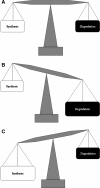Molecular therapy of the intervertebral disc
- PMID: 16835736
- PMCID: PMC2335383
- DOI: 10.1007/s00586-006-0155-3
Molecular therapy of the intervertebral disc
Abstract
Disc degeneration is the loss of the normal nucleus pulposus disc matrix to a more fibrotic and less cartilaginous structure. This change in disc micro-anatomy can be associated with pain and deformity, however, prevention and treatment options of disc degeneration are currently limited. Much research is going on to understand intervertebral discs at a molecular/ cellular level in hopes of creating clinically applicable options for treating disc degeneration. This review article will give insight into the current and developing status of treating intervertebral disc degeneration from a molecular standpoint.
Figures




Similar articles
-
Prevention of disc degeneration with growth factors.Eur Spine J. 2006 Aug;15 Suppl 3(Suppl 3):S422-32. doi: 10.1007/s00586-006-0149-1. Epub 2006 Jul 25. Eur Spine J. 2006. PMID: 16865380 Free PMC article. Review.
-
Growth factor expression in degenerated intervertebral disc tissue. An immunohistochemical analysis of transforming growth factor beta, fibroblast growth factor and platelet-derived growth factor.Eur Spine J. 2006 May;15(5):588-96. doi: 10.1007/s00586-005-0930-6. Epub 2005 Jun 25. Eur Spine J. 2006. PMID: 15980999 Free PMC article.
-
Quantitative MRI as a diagnostic tool of intervertebral disc matrix composition and integrity.Eur Spine J. 2008 Dec;17 Suppl 4(Suppl 4):432-40. doi: 10.1007/s00586-008-0744-4. Epub 2008 Nov 13. Eur Spine J. 2008. PMID: 19005703 Free PMC article. Review.
-
Biological repair of the degenerated intervertebral disc by the injection of growth factors.Eur Spine J. 2008 Dec;17 Suppl 4(Suppl 4):441-51. doi: 10.1007/s00586-008-0749-z. Epub 2008 Nov 13. Eur Spine J. 2008. PMID: 19005698 Free PMC article. Review.
-
Topographical guidance of intervertebral disc cell growth in vitro: towards the development of tissue repair strategies for the anulus fibrosus.Eur Spine J. 2006 Aug;15 Suppl 3(Suppl 3):S389-96. doi: 10.1007/s00586-006-0125-9. Epub 2006 May 11. Eur Spine J. 2006. PMID: 16688474 Free PMC article.
Cited by
-
ASIC1a activation induces calcium-dependent apoptosis of BMSCs under conditions that mimic the acidic microenvironment of the degenerated intervertebral disc.Biosci Rep. 2019 Nov 29;39(11):BSR20192708. doi: 10.1042/BSR20192708. Biosci Rep. 2019. PMID: 31696219 Free PMC article.
-
Cell signaling pathways related to pain receptors in the degenerated disk.Global Spine J. 2013 Jun;3(3):165-74. doi: 10.1055/s-0033-1345036. Epub 2013 May 9. Global Spine J. 2013. PMID: 24436867 Free PMC article. Review.
-
Adipose stem cells for intervertebral disc regeneration: current status and concepts for the future.J Cell Mol Med. 2008 Dec;12(6A):2205-16. doi: 10.1111/j.1582-4934.2008.00291.x. Epub 2008 Feb 24. J Cell Mol Med. 2008. PMID: 18298653 Free PMC article. Review.
-
Biologic response of degenerative living human nucleus pulposus cells to treatment with cytokines.Yonsei Med J. 2015 Jan;56(1):277-86. doi: 10.3349/ymj.2015.56.1.277. Yonsei Med J. 2015. PMID: 25510775 Free PMC article.
-
Poly(γ-glutamic acid) and poly(γ-glutamic acid)-based nanocomplexes enhance type II collagen production in intervertebral disc.J Mater Sci Mater Med. 2017 Jan;28(1):6. doi: 10.1007/s10856-016-5787-1. Epub 2016 Nov 24. J Mater Sci Mater Med. 2017. PMID: 27885573
References
-
- Pritzker KP. Aging and degeneration in the lumbar intervertebral disc. Orthop Clin North Am. 1977;8:66–77. - PubMed
-
- Buckwalter JA, Einhorn TA, Simon SR (eds) (2000) Orthopedic basic science: biology and biomechanics of the musculoskeletal system, 2nd edn. American Academy of Orthopedic Surgeons, Rosemont, pp548–555
Publication types
MeSH terms
Substances
LinkOut - more resources
Full Text Sources
Medical

